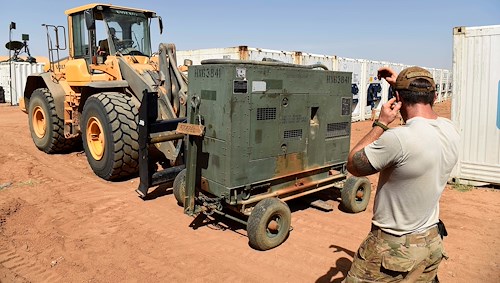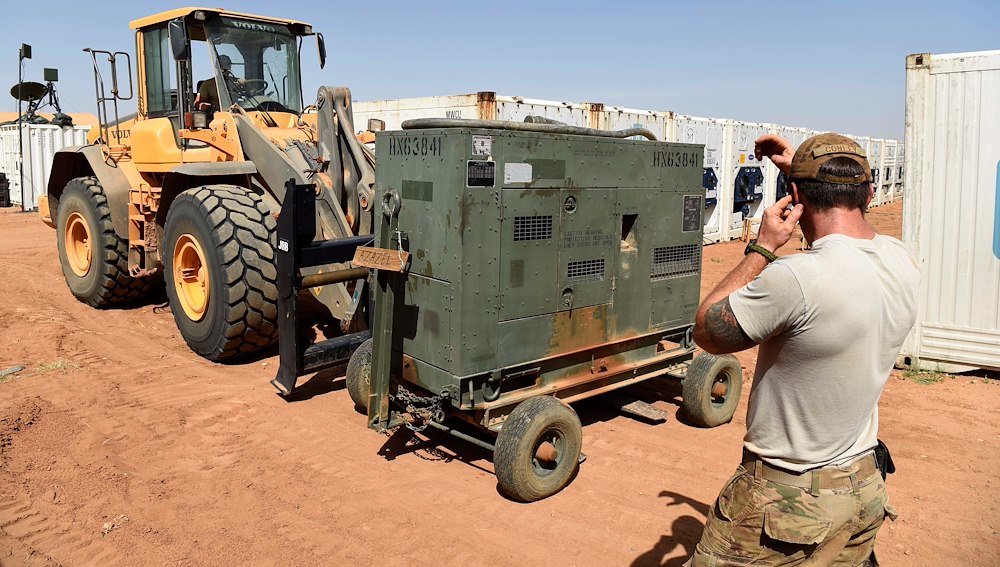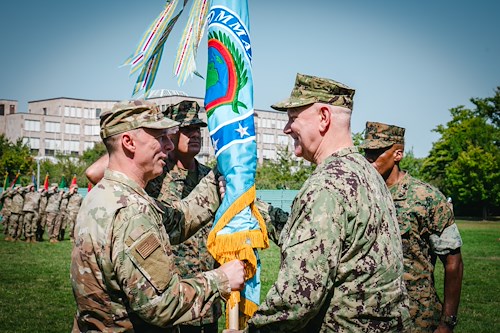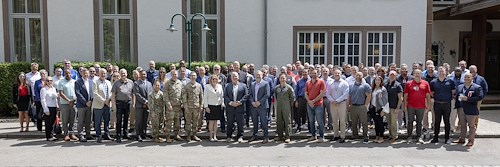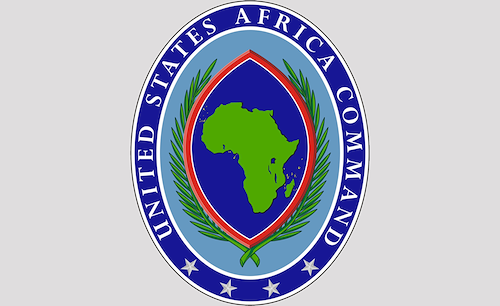Gallery contains 12 images
×
Photo 1 of 12
Air Base 201 at Agadez moves for FLEXIT
Airmen from the 724th Expeditionary Air Base Squadron move generators from their old base to a new location, Sept. 09, 2017, at Air Base 201, Agadez, Niger. The move to the bigger base is called “FLEXIT,” short for "Flintlock Exit.” Independent power sources are required to operate in such a remote location. (U.S. Air Force photo by Staff Sgt. Joshua R. M. Dewberry/released)
Photo by: Staff Sgt. Joshua Dewberry
Photo 2 of 12
Air Base 201 at Agadez moves for FLEXIT
Airmen from the 724th Expeditionary Air Base Squadron take down tents from the old base to move to a new location, Sept. 11, 2017, at Air Base 201, Agadez, Niger. The move to the bigger base is called “FLEXIT,” short for "Flintlock Exit.” Being located in this deployed environment requires temporary housing in lieu of traditional infrastructure. (U.S. Air Force photo by Staff Sgt. Joshua R. M. Dewberry/released)
Photo by: Staff Sgt. Joshua Dewberry
Photo 3 of 12
Air Base 201 at Agadez moves for FLEXIT
Airmen from the 724th Expeditionary Air Base Squadron move barrels of gas from their old camp site to a new location, Sept. 09, 2017, at Air Base 201, Agadez, Niger. The move to the bigger base is called “FLEXIT,” short for "Flintlock Exit.” The fuel is used to power generators, in turn powering cold storage units, HVAC and general electric requirements. (U.S. Air Force photo by Staff Sgt. Joshua R. M. Dewberry/released)
Photo by: Staff Sgt. Joshua Dewberry
Photo 4 of 12
Air Base 201 at Agadez moves for FLEXIT
Airmen from the 724th Expeditionary Air Base Squadron work on electric equipment connected to cold storage units at a new base location, Sept. 09, 2017, at Air Base 201, Agadez, Niger. The move to the bigger base is called “FLEXIT,” short for "Flintlock Exit.” All the electrical equipment at Air Base 201 must be able to function in hot weather and frequent dust storms. (U.S. Air Force photo by Staff Sgt. Joshua R. M. Dewberry/released)
Photo by: Staff Sgt. Joshua Dewberry
Photo 5 of 12
Air Base 201 at Agadez moves for FLEXIT
Major Carsten Stahr (left), 724th Expeditionary Air Base Squadron director of operations, takes down tents from the old base to move to a new location, Sept. 11, 2017, at Air Base 201, Agadez, Niger. The move to the bigger base is called “FLEXIT,” short for "Flintlock Exit.” Being located in this deployed environment requires tents to function as temporary housing in lieu of traditional infrastructure. (U.S. Air Force photo by Staff Sgt. Joshua R. M. Dewberry/released)
Photo by: Staff Sgt. Joshua Dewberry
Photo 6 of 12
Air Base 201 at Agadez moves for FLEXIT
Airmen from the 724th Expeditionary Air Base Squadron and Soldiers from the 411th Military Police Company, 89th MP Brigade, 1st Platoon, take down tents from the old base to move to a new location, Sept. 11, 2017,at Air Base 201, Agadez, Niger. The move to the bigger base is called “FLEXIT,” short for "Flintlock Exit.” Being located in this deployed environment requires temporary housing in lieu of traditional infrastructure. (U.S. Air Force photo by Staff Sgt. Joshua R. M. Dewberry/released)
Photo by: Staff Sgt. Joshua Dewberry
Photo 7 of 12
Air Base 201 at Agadez moves for FLEXIT
Master Sgt. Christopher Moffett, 724th Expeditionary Air Base Squadron flight superintendent, takes down tents from the old base to move to a new location, Sept. 11, 2017, at Air Base 201, Agadez, Niger. The move to the bigger base is called “FLEXIT,” short for "Flintlock Exit.” Being located in this deployed environment requires temporary housing in lieu of traditional infrastructure. (U.S. Air Force photo by Staff Sgt. Joshua R. M. Dewberry/released)
Photo by: Staff Sgt. Joshua Dewberry
Photo 8 of 12
Air Base 201 at Agadez moves for FLEXIT
An Airman from the 724th Expeditionary Air Base Squadron works on electric equipment connected to cold storage units at a new base location, Sept. 09, 2017, at Air Base 201, Agadez, Niger. The move to the bigger base is called “FLEXIT,” short for "Flintlock Exit.” All the electrical equipment at Air Base 201 must be able to function in hot weather and frequent dust storms. (U.S. Air Force photo by Staff Sgt. Joshua R. M. Dewberry/released)
Photo by: Staff Sgt. Joshua Dewberry
Photo 9 of 12
Air Base 201 at Agadez moves for FLEXIT
Airmen from the 724th Expeditionary Air Base Squadron take down tents from the old base to move to a new location, Sept. 11, 2017, at Air Base 201, Agadez, Niger. The move to the bigger base is called “FLEXIT,” short for "Flintlock Exit.” Being located in this deployed environment requires temporary housing in lieu of traditional infrastructure. (U.S. Air Force photo by Staff Sgt. Joshua R. M. Dewberry/released)
Photo by: Staff Sgt. Joshua Dewberry
Photo 10 of 12
Air Base 201 at Agadez moves for FLEXIT
An Airman from the 724th Expeditionary Air Base Squadron takes apart rope tying down tents at the old base to move to a new location, Sept. 11, 2017, at Air Base 201, Agadez, Niger. The move to the bigger base is called “FLEXIT,” short for "Flintlock Exit.” Being located in this deployed environment requires temporary housing in lieu of traditional infrastructure. (U.S. Air Force photo by Staff Sgt. Joshua R. M. Dewberry/released)
Photo by: Staff Sgt. Joshua Dewberry
Photo 11 of 12
Air Base 201 at Agadez moves for FLEXIT
Airmen from the 724th Expeditionary Air Base Squadron to work together to tear down tents from the old base to move to their new location, Sept. 11, 2017, at Air Base 201, Agadez, Niger. The move to the bigger base is called “FLEXIT,” short for "Flintlock Exit.” Being located in this deployed environment requires temporary housing in lieu of traditional infrastructure. (U.S. Air Force photo by Staff Sgt. Joshua R. M. Dewberry/released)
Photo by: Staff Sgt. Joshua Dewberry
Photo 12 of 12
Air Base 201 at Agadez moves for FLEXIT
Airmen from the 724th Expeditionary Air Base Squadron move the covers from tents from the old base to their new location, Sept. 11, 2017, at Air Base 201, Agadez, Niger. The move to the bigger base is called “FLEXIT,” short for "Flintlock Exit.” Being located in this deployed environment requires temporary housing in lieu of traditional infrastructure. (U.S. Air Force photo by Staff Sgt. Joshua R. M. Dewberry/released)
Photo by: Staff Sgt. Joshua Dewberry
AGADEZ, Niger – Airmen deploy around the world, getting the mission done day in and day out. However, few will get the chance to see their base being built from the ground up.
Even fewer will move it themselves. These special few include the men and women of the 724th Expeditionary Air Base Squadron in Agadez, Niger, participating in what is locally known as “FLEXIT,” short for “Flintlock Exit.”
“Our host nation was kind enough to let us set up a temporary base next to their local military basic training site while we established our base, eventually building up a flight line for air operations,” 1st Lt. Danielle Tabb, Civil Engineer Flight commander and base civil engineer said. “This move gives us more room to effectively work in a deployed environment, while still helping the Forces Armées Nigeriennes (FAN) build up their national defense.”
The uniqueness of this base is shared by few locations under Air Force control. While nearby terrorist cells and human smuggling are an ongoing threat, the remote location makes daily operations a task unto themselves.
“Logistics are the biggest challenges by far,” Maj. Carsten Stahr, 724th EABS director of operations said. “We’re in the Sahel (the zone of transition in Africa between the Sahara to the north and the Sudanian Savanna to the south), so we deal with anything from daily temperatures over 100 degrees, long shipping times for supplies, little to no infrastructure nearby, malaria, etc.”
Inclement weather is also a factor. Thunder and dust storms can delay operations when they do happen.
“Our equipment wasn’t built for this environment, so daily maintenance and monitoring is a must,” Tabb said. “This is a tough environment to work in, but we all still have a job to do and we do it well. If it’s hard for us to work out here even with all our equipment, imagine how difficult it is for the locals who don’t have very much.”
Members from every unit, whether it is fire fighters, HVAC, finance or the medical section, pitch in to help tear down and rebuild equipment and quarters in the new base location.
However, the state of affairs for the people of Niger has also been slowly improving. Even though Niger has one of the poorest economies in Africa, the presence of U.S. service members brings an increase of quality of life to the local population.
“We help the people improve their own lives by getting involved in a number of ways,” Stahr said. “We help train their recruits going through their basic military training, hosting bazaars for local vendors, teaching hygiene classes for better health and wellness, and so on.”
Airmen, to include the 724th EABS and 31st Expeditionary RED HORSE Squadron, and mission partners from the U.S. Army’s Military Police and the U.S. Navy’s Seabees work together to build up what is projected to be the biggest military labor troop project in U.S. Air Force history.
“We’re in the very early stages right now of establishing a presence in the area, but one day this once empty desert will be a fully functioning flight line,” Tabb said.
Until a flight line is built, the host nation allows the Air Force to use the local airport to import supplies and equipment.
“We’re building a good relationship with the people of Niger,” Stahr said. “We want to be good stewards of the land and help the locals improve their lives, while better understanding each other, even if we come from different parts of the world. Niger is a steadfast ally of the U.S. and we work with the people here every day to fight back against terrorism wherever it hides.”

